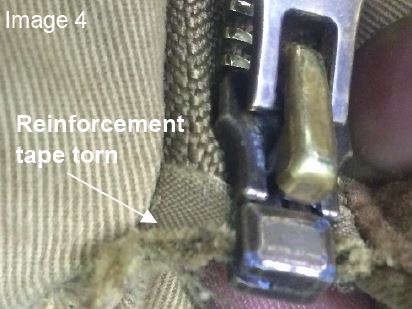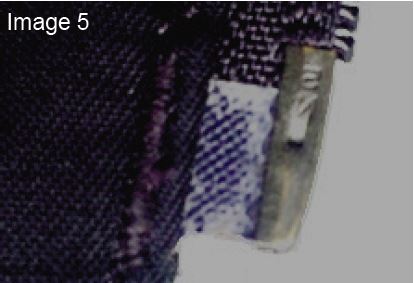
Protecting Zips While Washing
Contents
Introduction
Stain Migration during Mechanical Stone Wash
Elements / Teeth Breakage
Open Parts (Pin and Box) Breakage
Whitening of Transparent Film
Introduction
Washing denim to create a new and creative look and feel to the fabric has been an obsession of fashion designers for decades. Since it began, denim washing has evolved into several different styles and techniques, all of which have their own distinct appeal. It is the wash that gives denim its character.
Washed denim is either rubbed and worn down with stones or other abrasive materials (mechanical washing) or treated with bleach and other colour altering substances (chemical washing).
| Mechanical Wash | Chemical Wash |
|---|---|
| Stone | Enzyme |
| Whiskering | Bleach |
| Sandblasting | Acid |
| Grinding | Ozone Fading |
| Laser Technology | Over-Dyeing & Tinting |
| Scraping | |
| Superstone |
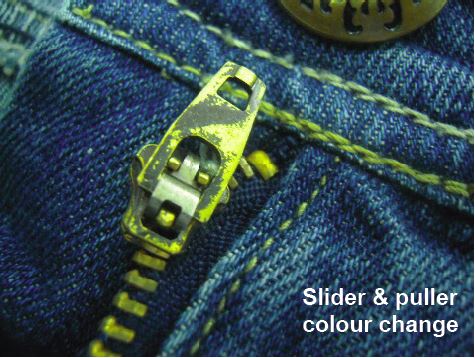
Stone washes with volcanic rocks or pumice stones added to the garments during washing process as well as sandblasting can lead to heavy abrasion of the garments. While these processes deliver the expected colour fade, it may also damage the zips to some extent. These heavy washes may leave obvious scratching and scraping on the metal surfaces of the zip’s components (including the teeth / elements, sliders, top stops or bottom stops). The degree of damage may vary depending on the size and ratio of the stones, the washing times, the load of garments etc.
Zips should always be closed to the top prior to any washing.
What can go wrong?
- Severe conditions of wash process
- Ineffective rinsing
- Inadequate control of chemical addition
Stain Migration during Mechanical Stone Wash
Due to the physical abrasion on the metal surfaces, metal dust may come off from the zip components and the mixture of the metal dust, stone fragments and dirt may remain on the metal surfaces of the zips. When they come in contact with the garment’s fabric, it may cause staining. Stain may look more obvious on lighter colour garments (image 1).
Unlike the stains caused by chemical reaction, this stain is physically attached to the surface of the fabric. Therefore, it can be simply removed by washing with organic solvent or detergent.
In order to prevent the undesirable staining of the garment, the zips should be protected from any direct contact with hard objects (e.g. stones) during garment washes. To ensure that the zip is closed to the top and covered by the garment’s fabric throughout the washing process will minimise this problem.
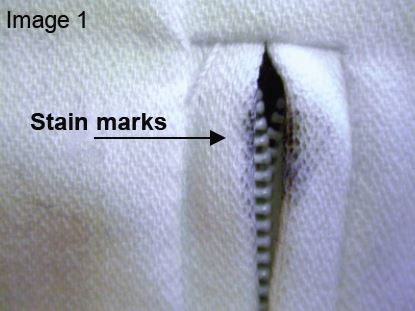
Elements / Teeth Breakage
The elements / teeth could be damaged / detached during wet processing (image 2) if the zip is forcefully opened / pulled inside the washing machine. In addition, such hard objects as pumice stones could scratch off the surface of the zip components, sometimes exposing the inner substrate.
In order to minimise the risk of teeth fall off, the zip should always be closed to the top during all wash cycles.
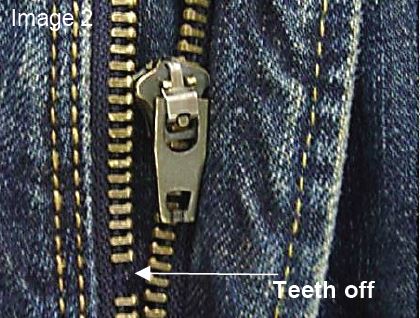
Open Parts (Pin and Box) Breakage
During wet processes, while the garments are tumbled in the washing / drying machine, the zips are repeatedly hit / rubbed against the inner wall of the machine. If not closed and protected properly, such small parts as retainer box or pin could get caught in the small holes of the machine, repeatedly pulled / twisted by the garments and could end up damaged or broken (image 3).
Closing the zip to the top prior to any washing will reduce this risk.
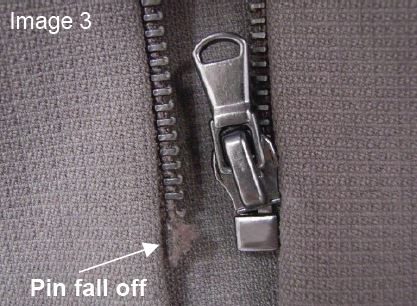
Whitening of Transparent Film
Transparent film is adhered by heat at the bottom ends of the open end zips to strengthen the tape during use and to prevent fraying.
During the washing processes, garments are tumbled and squeezed in the machine and the filmed tape ends also get squeezed / twisted and could be torn and damaged (image 4).
The film's adhesion onto the tape is thus weakened and if they are subjected to heat (e.g. drying or ironing), the adhesive can melt. The film may peel off from the tape, become hard, crispy and white (image 5).
Fabric based reinforcement film gives better results. Closing the zip and protecting / covering the bottom end of the zip with fabric can mitigate this problem.
